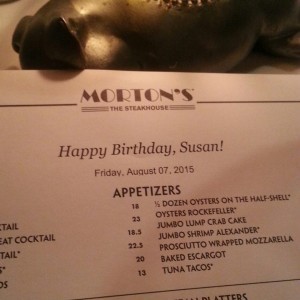S. Chris Edmonds's Blog, page 17
August 17, 2015
Is Your Company a “Best Places to Work”?
 24/7 Wall Street just released their 2015 “America’s Best Companies to Work For” list.
24/7 Wall Street just released their 2015 “America’s Best Companies to Work For” list.
They studied current and former employees’ company ratings and testimonials on Glassdoor.com to establish the top 54 best places to work.
Glassdoor’s ratings are very relevant. Employees rank a variety of factors beyond their personal satisfaction with the company, including pay, benefits, work-life balance, culture, leadership (including rating the CEO), and more.
On Glassdoor’s five-point scale, only nine of the 54 best places to work scored a 4.0 or better. Five of those are in technology, including Facebook, Google, LinkedIn, Adobe, and Apple. Rounding out the top ten are Insight Global, McKinsey & Company, Expedia, Nike, and Chick-Fil-A.
An interesting note: being a great place to work doesn’t guarantee financial success or consistent results! A number of the 54 companies on this list reported revenue losses, including T-Mobile.
I am much more impressed by companies that WOW their employees, WOW their customers, AND meet or exceed performance expectations. Those are my big three – engagement, customer service, and results. Hitting all three of those targets is much less common today.
I compared the top ten list of 24/7 Wall Street’s best places to work with their 2015 list of Customer Service Hall of Fame members.
Only two companies made both top 10 lists: Apple and Chick-Fil-A. Along with their top engagement scores and customer service ratings, both these companies have outstanding fiscal performance. Apple is expected to announce last quarter gross revenues of $49 billion, a 30 percent increase over the same quarter’s sales last year. Chick-Fil-A has enjoyed 47 consecutive years of sales growth – including nearly $6 billion in sales in 2014.
That sweet spot – delivering consistently on my big three – is a unique, exciting, rewarding experience for companies, their leaders, their customers, and employees.
How do you know how your team or department or company is doing on those big three? You need to do regular, honest assessment of employee engagement, customer service, and results. Most companies monitor results, profits, etc. hourly or daily, with major milestones assessed monthly.
Some companies gather regular customer service data. Too few gather employee engagement data, as well. Only when you have reliable data on each of these three elements can you assess your organization’s impact.
How can you make your team or department or company a great place to work? My research proves you can boost engagement, service, and results by doing these three things:
First, define minimum citizenship expectations. Effective leaders formalize how they expect everyone in the organization to treat each other and customers. By defining values in observable, tangible, measurable terms, a leader creates the opportunity for workplace interactions that demonstrate trust, respect, and dignity.
Second, define minimum contribution expectations. Effective leaders formalize performance standards. They ensure projects, goals, and tasks are specific, measurable, attainable, relevant, and trackable. By defining SMART performance standards, a leader creates a clear path to consistent contribution.
Third, hold everyone – including all leaders – accountable for both contributions and citizenship. Effective leaders model the team’s valued behaviors in every interaction – and demand that all players do the same. They measure, monitor, and reward performance traction and values alignment regularly. They don’t tolerate mis-treatment of others at any time.
If you don’t aim for the big three and hold others accountable for the big three, you won’t enjoy a high performing, values-aligned organization.
What is your experience? To what extent does your company measure engagement, service, and results? Share your insights on Twitter, Facebook, and LinkedIn.
Photo © Rido – Dollar Photo Club. All rights reserved.
 Podcast – Listen to this post now with the player below. Subscribe via RSS or iTunes.
Podcast – Listen to this post now with the player below. Subscribe via RSS or iTunes.
The music heard on my podcasts is from one of my songs, “Heartfelt,” copyright © 2005-2015 Chris Edmonds Music (ASCAP). I play all instruments on these recordings.
Don’t miss any of Chris’ posts, podcasts, or updates – Subscribe Now!
Disclosure of Material Connection: Some of the links in the post above are “affiliate links.” This means if you click on the link and purchase the item, I will receive an affiliate commission. Regardless, I only recommend products or services I use personally and believe will add value to my readers. I am disclosing this in accordance with the Federal Trade Commission’s 16 CFR, Part 255: “Guides Concerning the Use of Endorsements and Testimonials in Advertising.”

August 10, 2015
Customer Service Polarities
 How often are you positively WOW’ed by the customer service you experience? According to Tempkin’s new customer service ratings, the best service providers include USAA in banking, credit cards, and insurance categories, Chick-Fil-A in the fast food category, and Aldi, Trader Joe’s, and Publix in the supermarket category.
How often are you positively WOW’ed by the customer service you experience? According to Tempkin’s new customer service ratings, the best service providers include USAA in banking, credit cards, and insurance categories, Chick-Fil-A in the fast food category, and Aldi, Trader Joe’s, and Publix in the supermarket category.
This week brought examples of great and not so great customer service. Customer service is mediocre at best in our day to day experiences. It typically takes something really amazingly good and on target for us to be impressed at the service experience.
And, it typically takes something amazingly bad and off target for us to notice how awful the service experience is.
The great service experience was shared by Marsha Collier, best selling author and radio host. Marsha’s daughter Susan Dickman was born on August 7. Marsha, her husband Curt, and Susan celebrated Susan’s birthday at Morton’s, a steakhouse outside of LA.
Morton’s restaurants around the USA are renowned for great food, great ambiance, and great service. Marsha posted a picture (at right) of the menu the wait staff provided to their group. Boldly printed across the top: “Happy Birthday, Susan!”
That effort is one of many ways Morton’s creates service excellence. For this restaurant, it was a simple, inexpensive customization of that night’s menu for that one table. For Marsha, Curt, and Susan, it was a personal, caring touch that helped make their customer experience awesome.
The challenge that service providers like Morton’s face is that one slip-up can undermine the aligned behavior of a dozen colleagues. If the meal wasn’t perfectly prepared or of top quality or the wait staff interactions weren’t kind or if the chefs began arguing loudly in the open kitchen, that personalized menu alone would not have saved the day.
On the same evening, at about the same time, three states away, a very different service experience was found in a remote mountain community.
Our client had booked six rooms for band members at an independently run motel in town. After setting up our gear and completing our sound check, four of us rushed over to check in, change clothes, and head back for the Friday show.
One of my bandmates engaged the lone staff member at the registration counter in the lobby. The receptionist was remarkably, casually, completely rude and dismissive.
She was disturbed that we didn’t have a confirmation number, even after told that our client didn’t provide it to us.
When I attempted to engage with her, she said calmly, “I’m not talking to you. I’m talking to him.”
My bandmate was pleasant yet persistent. We got five rooms (better than nothing during the town’s major tourist event). When got my key card, I asked the receptionist to direct me to my room. She said, “I already told him (pointing to my bandmate).”
Other guests were waiting in line to check in. They observed her behavior and knew they’d get more of the same.
The rooms were dated but quiet and comfortable. The band had stayed in much lesser quality lodging during the past nine years of performing together. We all agreed, though, that we’d never seen a receptionist that treated guests – us – so completely badly. It was world class awful.
The challenge that service providers like this local motel face is that one bad hire – that “gatekeeper” receptionist – can undermine the aligned behavior of a dozen colleagues. It didn’t matter that the rooms were quiet and comfortable – the damage had been done.
The second night we stayed at a B&B that was booked solid on Friday. The owner was delighted to host the band and wished she’d had room for us our first night in town (especially after we told her of our experience at the motel).
Two completely opposite customer experiences happened, one great, one lousy. The stories of both experiences get told and repeated far and wide.
Customer service matters. Your business will thrive if you’re able to align every player, every practice, and every interaction to service values.
What is your experience? How much attention is paid in your organization to the customer experience? Share your insights on Twitter, Facebook, and LinkedIn.
Photo © Marsha Collier. All rights reserved.
 Podcast – Listen to this post now with the player below. Subscribe via RSS or iTunes.
Podcast – Listen to this post now with the player below. Subscribe via RSS or iTunes.
The music heard on my podcasts is from one of my songs, “Heartfelt,” copyright © 2005-2015 Chris Edmonds Music (ASCAP). I play all instruments on these recordings.
Don’t miss any of Chris’ posts, podcasts, or updates – Subscribe Now!
Disclosure of Material Connection: Some of the links in the post above are “affiliate links.” This means if you click on the link and purchase the item, I will receive an affiliate commission. Regardless, I only recommend products or services I use personally and believe will add value to my readers. I am disclosing this in accordance with the Federal Trade Commission’s 16 CFR, Part 255: “Guides Concerning the Use of Endorsements and Testimonials in Advertising.”

August 3, 2015
Three Ways Servant Leaders Recognize Employees
 “The deepest principle in human nature is the craving to be appreciated.”
“The deepest principle in human nature is the craving to be appreciated.”
― William James
How many of you get enough praise on the job? I ask this question at nearly every keynote I deliver. The results are astounding. Less than 10 percent of audience members raise their hands!
My informal social research mirrors that of Tiny HR’s 2014 Employee Engagement and Organizational Culture Report which found that only 21 percent of employees feel strongly valued at work.
A 2010 study by Psychometrics Canada found that 69 percent of HR professionals believe that engagement is a problem in their organizations. When asked what leaders can do to improve engagement, 52 percent replied, “Give recognition.”
It is clear that there is too little praise and encouragement that happens in our organizations today.
As William James said, humans crave appreciation. My 25 years of research and experience leads me to the conclusion that humans also crave validation, trust, and respect.
If leaders want better results and higher profits, they’d be remiss if they ignore the positive impact of employee recognition and engagement.
When team members feel appreciated, validated, trusted, and respected, significant benefits occur. Engagement goes up, by 40 percent or more. Customer service ratings go up, by 40 percent or more. Results and profits improve by 35 percent or more.
How do great leaders – servant leaders – recognize their employees? They do three things consistently.
First, recognition is personal. Servant leaders know that relationships drive everything in our hectic world. They spend time daily networking with team leaders and team members, casually and informally. When they praise someone, their preferred means is to do so face-to-face. If face-to-face won’t work, they don’t delay – they call the person to recognize them voice-to-voice. If a live call won’t work, they don’t delay – they write a personal note, thanking them for their efforts and contribution.
Second, recognition is authentic. Servant leaders gather key information before they deliver praise. They learn what the opportunity was, what the person did, and what the impact was on their customer, team, and the company. They include that information in their recognition, which makes the conversation authentic and meaningful. A simple “Atta boy” or “Atta girl,” without the context of what the player did to deserve recognition, is meaningless.
Third, recognition is frequent. Servant leaders take time daily to learn about good things that are happening and then promptly praise those good things. Servant leaders resist the temptation to sit at their desks engaged in solitary activities. Leadership is a verb! Servant leaders have “scouts” that report back the good things that are happening in the business. Servant leaders praise quickly – they don’t want the sun to set without praising that day’s aligned actions. They spend time daily “wandering around” their operation, looking for and recognizing things going well.
Employee recognition is not a complex process. Leaders, boost engagement, service, and results by recognizing your employees – personally, authentically, and frequently.
What do you think? How did your best bosses recognize leaders and team members? How do you praise and recognize your peers at work today? Share your insights on Twitter, Facebook, and LinkedIn.
Photo © bzyxx – Dollar Photo Club. All rights reserved.
 Podcast – Listen to this post now with the player below. Subscribe via RSS or iTunes.
Podcast – Listen to this post now with the player below. Subscribe via RSS or iTunes.
The music heard on my podcasts is from one of my songs, “Heartfelt,” copyright © 2005 Chris Edmonds Music (ASCAP). I play all instruments on these recordings.
Don’t miss any of Chris’ posts, podcasts, or updates – Subscribe Now!
Disclosure of Material Connection: Some of the links in the post above are “affiliate links.” This means if you click on the link and purchase the item, I will receive an affiliate commission. Regardless, I only recommend products or services I use personally and believe will add value to my readers. I am disclosing this in accordance with the Federal Trade Commission’s 16 CFR, Part 255: “Guides Concerning the Use of Endorsements and Testimonials in Advertising.”

July 27, 2015
What Drives Your Leadership Behaviors?
 Why do leaders do what they do? I believe that leaders’ plans, decisions, and actions are heavily influenced by three things: their social style or personality type, the culture in which they operate, and their role models (past and present).
Why do leaders do what they do? I believe that leaders’ plans, decisions, and actions are heavily influenced by three things: their social style or personality type, the culture in which they operate, and their role models (past and present).
Each of these three are powerful, yet we may not be completely aware of how they drive our behavior as leaders.
Our social style is made up of traits we are born with (“wired” preferences) as well as traits we accommodate (“acquired” preferences) through interactions with others, typically in our youth. (Yes, these acquired traits are influenced by role models and the culture we operate in!).
If you’ve taken a DISC assessment or MBTI profile, you get a snapshot of your preferences for that role (DISC) or for your life (MBTI). Our leadership tendencies like driving for results or supporting team members or ignoring conflict or being aggressive with others can be attributed to our social style.
The culture we operate in can guide us – sometimes subtly, sometimes brazenly – to behave in ways we might not otherwise model.
If you were a senior leader at Toshiba in the last five years, the culture might have influenced you to tolerate scandalous accounting practices that inflated the company’s earnings by $1.2 billion. Where an organization’s culture rewards aggressive sales, you might embrace those tactics to earn “your share of the gold” this quarter. If you operate in a values-aligned tribal culture like the WD-40 Company, you share your learning moments (mistakes) willingly so others won’t make the same mistake.
Role models are powerful. If a past boss micromanaged me and I hated it, it is unlikely that I micromanage my team members today. If a past boss yelled to get his or her way, and us team members delivered, it is likely that I will yell when trying to “inspire” my team’s performance. If a past boss held team members accountable – kindly but firmly – for both performance and for citizenship, it is likely that I will do the same, kindly but firmly.
Role models can include our parents, teachers, coaches, professors, friends, enemies, public figures, and presidential candidates.
Effective leaders are able to examine the drivers of their daily “influencing” behaviors and embrace those drivers that help them serve others, exceed shared goals, and live desired values. They invite others to share their perceptions of how well they are leading.
One client described a manager that recently announced the values that he expected his team members to embrace moving forward. His demands were not credible for two big reasons. First, he didn’t include team members in the creation of those values; he simply announced them. Second, this leader does not model the values he was asking others to demonstrate.
As you might guess, the team is frustrated by the leader’s demands. The leader is frustrated by the team’s frustration. It’s not going well.
A recent article on new Denver Broncos football coach Gary Kubiac shed light on his leadership behaviors over time. Texas A&M coach R.C. Slocum gave Kubiac his first coaching job in 1992. Slocum said he knew Kubiac would be a head coach before long. Slocum explained, “Players loved him. And he didn’t think he had all the answers. As a head coach, you have the right to be demanding, but you don’t have the right to be demeaning.”
“Gary leads with class.”
Don’t assume you’re an effective leader. Ask for help. Learn others’ perceptions of you. Understand your unique drivers, and refine your efforts to consistently be of service and of grace.
What do you think? How well do you serve others kindly while driving for results? Share your insights on Twitter, Facebook, and LinkedIn.
Photo © .shock – Dollar Photo Club. All rights reserved.
 Podcast – Listen to this post now with the player below. Subscribe via RSS or iTunes.
Podcast – Listen to this post now with the player below. Subscribe via RSS or iTunes.
The music heard on my podcasts is from one of my songs, “Heartfelt,” copyright © 2005 Chris Edmonds Music (ASCAP). I play all instruments on these recordings.
Don’t miss any of Chris’ posts, podcasts, or updates – Subscribe Now!
Disclosure of Material Connection: Some of the links in the post above are “affiliate links.” This means if you click on the link and purchase the item, I will receive an affiliate commission. Regardless, I only recommend products or services I use personally and believe will add value to my readers. I am disclosing this in accordance with the Federal Trade Commission’s 16 CFR, Part 255: “Guides Concerning the Use of Endorsements and Testimonials in Advertising.”

July 20, 2015
Everyone Has Values
 I had a wonderful conversation online recently with a leader who disagreed with me. I love to engage people with different points of view in a respectful manner (from both sides!).
I had a wonderful conversation online recently with a leader who disagreed with me. I love to engage people with different points of view in a respectful manner (from both sides!).
My post and podcast last week (Surround Yourself With Values-Aligned Compadres) prompted the discussion.
Twitter discussions are interesting. The 140-character limit means one has to be crisp & clear with sometimes complicated concepts. Let me paraphrase our conversation.
This leader said, “I wish more people had values. Too few do!” I believe I knew what he meant – that many people don’t seem to act in alignment with values. My take is that everyone has values. Everyone aligns to their values daily. We can observe their values by examining their plans, decisions, and actions.
I responded with, “Everyone has values. Bullies have values. Teen gang members have values. They just hold values that are different than my own.”
The leader said, “I don’t think thugs have values!” No question about what this leader believes, right?
My responses might have helped this leader see this concept from a different angle.
My experiences with values alignment began formally four decades ago, in my YMCA days.
In the 1970’s I was actively involved in values clarification. A couple of my bosses used values clarification in our work teams. I used it with my camp directors and counselors to ensure we were all on the same page with how we’d treat each other, how we’d treat our campers, and how we’d treat their family members each summer.
In all the values clarification sessions I ran – for literally hundreds of people – not one person failed to come up with their personal values. The values might have varied widely from person to person – especially with how they defined their values – but every person was satisfied with their values list.
I also learned how values-aligned teen gangs are. The national project I directed looked at teen programs and what the teens of “today” (in the early ’80’s) were looking for in their lives. We conducted hundreds of interviews with teens and parents. One of the most valuable resources for us was a study that came from the University of Michigan’s Institute for Social Research.
That study found that teens were looking for three things. First, they want do do things that are cool, different from things they do with their families. Second, they want to belong to a group (as opposed to isolating themselves). Third, they want to do things with that group that advance their group’s meaningful purpose.
In our discussions of this powerful data, we realized these three things are true for teen gangs. Gang members are as values-aligned as US Marines or Zappos team members. Those three groups hold very different values, but each embrace their “team” values deeply.
This data and my experiences lead me to believe strongly that everyone has values. We experience others’ values in the ways they treat others (including how they treat us). We experience others’ values in the decisions they make. We often question their decisions from a values standpoint. In our heads, we think, “I would never do that! I value my independence (or family or faith or whatever) too much to go down that path!”
Right now, we each are acting on our values. The beliefs and principles we hold dear guide our individual plans, decisions, and actions.
By formalizing my values, I can quickly assess how well I’m living them each day. And, I can quickly assess the values of people in my life – at work, home, community, etc. – and can then assess how aligned their values are with mine.
And I can choose who to hang out with, who to work with, and who to spend my life with.
What do you think? Do you agree that everyone has values? Share your insights on Twitter, Facebook, and LinkedIn.
Photo © Catalin Pop – Dollar Photo Club. All rights reserved.
 Podcast – Listen to this post now with the player below. Subscribe via RSS or iTunes.
Podcast – Listen to this post now with the player below. Subscribe via RSS or iTunes.
The music heard on my podcasts is from one of my songs, “Heartfelt,” copyright © 2005 Chris Edmonds Music (ASCAP). I play all instruments on these recordings.
Don’t miss any of Chris’ posts, podcasts, or updates – Subscribe Now!
Disclosure of Material Connection: Some of the links in the post above are “affiliate links.” This means if you click on the link and purchase the item, I will receive an affiliate commission. Regardless, I only recommend products or services I use personally and believe will add value to my readers. I am disclosing this in accordance with the Federal Trade Commission’s 16 CFR, Part 255: “Guides Concerning the Use of Endorsements and Testimonials in Advertising.”

July 13, 2015
Surround Yourself with Values-Aligned Compadres
 Who you hang out with has a great influence on you.
Who you hang out with has a great influence on you.
If you hang out with bigoted people, you will likely embrace bigoted ideals. If you hang out with dishonest people, you will likely embrace dishonesty. If you hang out with people who are kind, who treat others with respect, who embrace serving others, who keep their promises, you will likely embrace those traits.
When I was growing up, my parents were very particular about who I hung out with. On our street in the suburbs of Long Beach, CA, in the ’60’s, there were more than 50 kids my age. It was very easy for my parents and our neighbors to observe what we were doing and with whom. We all played on the street, within full view of a network of stay-at-home moms.
I got most of my redirection from my folks at the dinner table each evening. “I like that you’re playing with Tim; he’s a nice boy.” “I don’t want you playing with Larry. He’s a bully.” “Carol is mean. Stay away from her.”
When I went off to college, my parents voices’ were in my head. I observed how my fellow students treated others. If they were mean, I kept my distance. If they were selfish, I chose to spend time elsewhere. If they were pleasant, fun, and kind, I hung out with them. If Linda kept her promises, that deepened my respect for her.
Warren Buffet was asked years about about what he looks for in people. He replied, “Somebody once said that in looking for people to hire, you look for three qualities: integrity, intelligence, and energy. And if you don’t have the first, the other two will kill you.” Buffet applies the same three criteria to leaders of companies he’s considering for investment.
If you are rock climbing or on a high ropes course, you’ll have someone “on belay.” They’ll loop your climbing rope securely through the belay device on their harness. They’ll control the slack so if you fall, you won’t fall far! You want your belay partner to be values-aligned – to care for you and your safety, to pay attention every second, and to be skilled in managing the rope, supporting your success.
Before you can examine the values of those around you, you must clarify your own purpose and values. You must formalize your personal constitution. It will include your present day purpose, your reason for being on this planet. It will include your values, how you define each value, and a list of 3-4 behaviors that are measurable indications of how you’ll live your values. Finally, it will include your leadership philosophy – how you choose to effectively influence others around you to contribute and serve their families, communities, and workplaces.
With those vital elements clear, you can easily assess the degree of alignment you have with your friends and colleagues. Values alignment boils down to integrity. If you see players who don’t model integrity, insulate yourself from them, as much as possible. Choose to engage often with players who demonstrate integrity, intelligence, and energy for life, daily.
By surrounding yourself with values-aligned compadres and comadres, you build a supportive team that can help you keep on track with your best self, every day.
How values-aligned are your friends and colleagues? How did key adults in your life direct you to values-aligned players? Share your insights on Twitter, Facebook, and LinkedIn.
Photo © vitaliymateha – Dollar Photo Club. All rights reserved.
 Podcast – Listen to this post now with the player below. Subscribe via RSS or iTunes.
Podcast – Listen to this post now with the player below. Subscribe via RSS or iTunes.
The music heard on my podcasts is from one of my songs, “Heartfelt,” copyright © 2005 Chris Edmonds Music (ASCAP). I play all instruments on these recordings.
Don’t miss any of Chris’ posts, podcasts, or updates – Subscribe Now!
Disclosure of Material Connection: Some of the links in the post above are “affiliate links.” This means if you click on the link and purchase the item, I will receive an affiliate commission. Regardless, I only recommend products or services I use personally and believe will add value to my readers. I am disclosing this in accordance with the Federal Trade Commission’s 16 CFR, Part 255: “Guides Concerning the Use of Endorsements and Testimonials in Advertising.”

July 6, 2015
What’s Your Story?
 In the midst of our hectic lives, who are we being? It is easy to get caught up in the frantic pace we see around us or that our work places reinforce – and not be our best selves every minute.
In the midst of our hectic lives, who are we being? It is easy to get caught up in the frantic pace we see around us or that our work places reinforce – and not be our best selves every minute.
We have a lot of stuff on our plates. We have many items on our to-do lists. We want to keep our commitments. That’s good – but I suggest that we’re not contributing like we can. We’re not serving like we can.
Frantic activity alone may not be the best way to spend our time on this earth!
We must be more intentional about who we are, about how we’re acting, about how we’re treating others, and about “to what end” we’re toiling.
And, if we are not clear about these important things, we will be used by people who are.
We need to understand our unique purpose on this planet, the values that guide us, and our unique talents. We need to understand our story. Only then are we able to clarify whether our plans, decisions, and actions are aligned with our best selves.
My story is grounded upon character and values. From my family, I learned the importance of honesty, keeping commitments, serving others, and bettering yourself. In high school I learned that pride can get in the way of integrity. In my first job at our local YMCA, I learned about values clarification, teamwork, and follow through.
In college I learned that people can proclaim many beliefs but how they treat others reveals their true selves. I found synergy and success when working with people who challenged me, shared my values, and laughed a lot.
In my early career I learned that leadership is a verb! My best bosses were proactive with us, defining exactly what was expected of us performance-wise and citizenship-wise. My less effective bosses focused only on performance, which encouraged “I win, you lose” behaviors from colleagues. Those actions inhibited teamwork, service, and overall performance.
My best bosses taught me about the tremendous importance of a values-aligned culture. It drives top performance, top engagement, and top service. Culture is a passion, and I’m inspired to help leaders craft effective cultures every day.
What’s your story? What life principles came clear to you while growing up, while in school, while in your first jobs? How did interactions with your parents, teachers, coaches, friends, colleagues, and bosses influence your beliefs?
Take time away from frantic activity, away from social media, away from your connected devices, to reflect on these questions – and write out your insights. Those insights will help you formalize your life purpose, your values and behaviors, and your life philosophy. Once those critical elements are clear, you can easily see which of your activities and behaviors are aligned and which are not.
Spend more time in aligned activities and less time in mis-aligned ones. The changes you make will help you know and act from your best self in every interaction.
That’s a story that’s worth living.
How clear is your team or company’s present day purpose? Do team members understand your strategies and goals well enough to articulate them to others? Share your insights on Twitter, Facebook, and LinkedIn.
Photo © william87 – Dollar Photo Club. All rights reserved.
 Podcast – Listen to this post now with the player below. Subscribe via RSS or iTunes.
Podcast – Listen to this post now with the player below. Subscribe via RSS or iTunes.
The music heard on my podcasts is from one of my songs, “Heartfelt,” copyright © 2005 Chris Edmonds Music (ASCAP). I play all instruments on these recordings.
Don’t miss any of Chris’ posts, podcasts, or updates – Subscribe Now!
Disclosure of Material Connection: Some of the links in the post above are “affiliate links.” This means if you click on the link and purchase the item, I will receive an affiliate commission. Regardless, I only recommend products or services I use personally and believe will add value to my readers. I am disclosing this in accordance with the Federal Trade Commission’s 16 CFR, Part 255: “Guides Concerning the Use of Endorsements and Testimonials in Advertising.”

June 29, 2015
The Leadership Void
 When I’m invited in to help executives refine their organization’s culture, I start with learning as much as I can about the executive team before I start learning about their company.
When I’m invited in to help executives refine their organization’s culture, I start with learning as much as I can about the executive team before I start learning about their company.
Why? Because leaders of organizations maintain the current culture, whether it’s beneficial or not, productive or not, engaging or not – and whether they know it or not! Senior leaders of teams, departments, regions, business units, etc. have the authority and responsibility to change policies, procedures, and norms – which can change the culture for the better.
My discovery process allows me to learn who this executive team is, how they lead their organization, how they communicate, what they validate (through recognition and praise), what they value, and what their desired culture is.
I immerse myself in relevant data – documents like employee satisfaction or engagement survey results, mission statements, strategic plans, internal newsletters, and more. I spend hours reviewing these cultural “artifacts” before I begin executive interviews, which offers much more detailed information on the executive team and how it operates.
One client shared their new vision statement and strategic plan. The CEO was quite proud of these documents. He told me, “We worked for two weeks on the vision statement. The strategic plan didn’t take that long – we already had pieces of it formalized.”
The problem? The vision statement was full of buzzwords and didn’t specify what this company did for their customers or why customers should care. It simply stated that the company “creates value for shareholders, employees, and customers.”
The strategic plan didn’t include any clear strategies at all. There was no outline of new customer needs to be addressed or new market opportunities that will be explored. The plan simply presented percentage growth targets for existing products and services.
I asked the CEO what employees’ responses were to the vision and strategic plan. He said reaction was rather subdued – and that the executive team had gotten feedback that employees didn’t know what the company’s strategy was, even after reading the documents.
These documents were not helpful. They didn’t provide the clarity that was desperately needed. The vision wasn’t clear. The strategy wasn’t clear.
This organization was operating in a leadership void. In the absence of leadership, strong personalities fill the void. We’ve all seen it.
In some cases, those strong personalities provide clarity of purpose and strategy. Those strong personalities create a cooperative work environment. They propose clarity and direction, and proactively align plans, decisions, and actions to move their team forward.
However, in most cases, these strong personalities provide clarity for the player’s own benefit – not the team’s or organization’s benefit. An “I win, you lose” mentality gets embedded. What gains traction are norms that pit people against each other rather than aligning each other to common goals and shared values.
Left to our own devices, us humans typically serve ourselves rather than engaging together to serve others. Politics and power become the coin of the realm, not cooperation and service.
The executive team I worked with didn’t realize they were causing difficulties with their bland vision and strategic plan. They didn’t intend to abdicate leadership – and they were frustrated to learn that’s exactly what they’d done.
I worked with the executive team to create a more actionable, present day purpose statement and a clarified strategic plan that set context for business branding, marketing, and operations for the next three years.
Their executive team is embracing their purpose, values, strategies, and goals. They’re working cooperatively so that every function and unit aligns to their company’s organizational constitution.
They’re not done yet, but the politics, power plays, and self-centered behaviors are diminishing.
The executive team is optimistic about their culture transition, which is terrific.
How clear is your team or company’s present day purpose? Do team members understand your strategies and goals well enough to articulate them to others? Share your insights on Twitter, Facebook, and LinkedIn.
Photo © alpha spirit – Dollar Photo Club. All rights reserved.
 Podcast – Listen to this post now with the player below. Subscribe via RSS or iTunes.
Podcast – Listen to this post now with the player below. Subscribe via RSS or iTunes.
The music heard on my podcasts is from one of my songs, “Heartfelt,” copyright © 2005 Chris Edmonds Music (ASCAP). I play all instruments on these recordings.
Don’t miss any of Chris’ posts, podcasts, or updates – Subscribe Now!
Disclosure of Material Connection: Some of the links in the post above are “affiliate links.” This means if you click on the link and purchase the item, I will receive an affiliate commission. Regardless, I only recommend products or services I use personally and believe will add value to my readers. I am disclosing this in accordance with the Federal Trade Commission’s 16 CFR, Part 255: “Guides Concerning the Use of Endorsements and Testimonials in Advertising.”

June 22, 2015
Your Character is Showing
 The 2016 US presidential race is heating up, which means the time is ripe for truth-stretching, name calling, and worse.
The 2016 US presidential race is heating up, which means the time is ripe for truth-stretching, name calling, and worse.
This week’s “I’m running for president” announcement by one candidate was so filled with distortions and untruths that fact checkers immediately pounced.
In another case, a news anchor was suspended for six months for “misrepresenting” his reporting experiences. In an interview this week, the anchor said his ego drove him to embellish stories.
What causes humans to embellish, to lie, to discount others, to take credit, or worse? Financial gain or showing they are smarter than others or winning while someone loses are outcomes that may drive us to lie.
For me, it all boils down to character – moral character. And, moral character matters.
Moral character is at the heart of many philosophers’ ideologies. We can learn about virtue and character through the writings of Aristotle, Plato, Heraclitus and others.
In fact, one of Heraclitus’ most popular quotes is “ethos anthropos daimon“, which roughly translates as “character is fate” or “character is destiny.”
Being of strong moral character means we are trustworthy. We are reliable. We do what we say we will do. We treat others with dignity and respect. Not once in a while, not most of the time, but all of the time, in every interaction.
Every plan, decision, and action reveals our character. We may think that our selfish drive is invisible to others, but it is not. It is amazingly transparent and consistent. If we are self-serving, it is obvious. If we are of service to others, it is obvious.
I have utmost control over the quality of my moral character. Should I be of grace and of service today, or should I screw everyone over so “I win” and they lose? It’s my choice.
Maintaining strong moral character takes effort, energy, reflection, and intention. It doesn’t happen naturally. We live in a society that reinforces “I, ME, MINE,” daily. If we want something different, something that serves others more than ourselves, we have to invest in those behaviors and those decisions.
Even when you are successful in aligning to strong moral character, others around you might behave in less giving ways.
For example, my worst boss asked me to lie. Years ago, in my non-profit executive life, my branch team of volunteers and staff worked our butts off to raise $25,000, which was double what they had ever raised before. But at the campaign’s closing dinner, with 300 people in attendance, my boss told me to get up in front of everyone and tell them we had raised, not $25,000, but $30,000. I refused, and announced the real total.
My boss wasn’t happy. Neither was I. He felt that I let him down. I felt that he had revealed his true moral character, and I had discovered his values were much different than mine. I didn’t want to interact with him anymore. I left that job as quickly as I could.
Make the choice today to be trustworthy, to do what you say you will do, to be kind, to be gracious, to express gratitude for effort as well as for accomplishment, to be reliable, to be respectful with everyone.
You’ll be able to hold your head high – and you might even influence others to be more respectful and of service, over time.
How do you maintain your strong moral character? How do others whom you respect demonstrate their strong moral character? Share your insights on Twitter, Facebook, and LinkedIn.
Photo © Steven Coburn – Dollar Photo Club. All rights reserved.
 Podcast – Listen to this post now with the player below. Subscribe via RSS or iTunes.
Podcast – Listen to this post now with the player below. Subscribe via RSS or iTunes.
The music heard on my podcasts is from one of my songs, “Heartfelt,” copyright © 2005 Chris Edmonds Music (ASCAP). I play all instruments on these recordings.
Don’t miss any of Chris’ posts, podcasts, or updates – Subscribe Now!
Disclosure of Material Connection: Some of the links in the post above are “affiliate links.” This means if you click on the link and purchase the item, I will receive an affiliate commission. Regardless, I only recommend products or services I use personally and believe will add value to my readers. I am disclosing this in accordance with the Federal Trade Commission’s 16 CFR, Part 255: “Guides Concerning the Use of Endorsements and Testimonials in Advertising.”

June 15, 2015
Everybody Knows Your Name
 How well do your employees – team members in your organization – know each other? If you want a work environment that values positive relationships as well as top performance, this is an important question to consider.
How well do your employees – team members in your organization – know each other? If you want a work environment that values positive relationships as well as top performance, this is an important question to consider.
Years ago I studied the W.L. Gore company. Their unique culture, based on a holacracy (no bosses), has served that company well since it’s founding over 50 years ago.
In discussions with key Gore leaders, I learned about another practice they embrace to this day. Their functional teams and plants are no larger than 300 people. Why? “When those units get too large, nobody knows your name,” one VP explained. “In smaller units, people feel more involved and connected.”
In a 2010 interview with Gary Hamel, Gore CEO Terri Kelly says that in big business units or plants, “the sense of ownership, the involvement in decision-making, the feeling that I can make an impact starts to get diluted.”
Tom Peters tells the story of a company that was facing a complicated project with aggressive deadlines. The company had brought in experts from other organizations from around the globe. The project team was really struggling to get clear on how they’d work together, on how they’d blend their various skills to deliver this project on time, under budget, and with a minimum of drama. Tom says, “They discovered a remarkable tool to get people to cooperate. The tool? A BBQ!”
Peters describes how this classic casual meal together helped team members learn about their project team peers away from the demands and pressures of the project. They learned about each others’ passions, hobbies, and stories. The BBQ’s worked so well, they held them each week. These BBQ’s became this team’s “community foundation.” Relationships improved. Cooperation improved. Solutions were arrived at and implemented.
Later, after the project was delivered to rave reviews, the company credited the team’s success to those BBQ’s.
My son Andy experienced the power of casual social gatherings recently. He’s a huge board game fan. He found peers at his job (in a big box home improvement store) who were also board game fans – so, he invited six people over for an evening of board games.
They had a ball. He said everyone “knew” each other from work but they hadn’t spent any time connecting or visiting beyond work responsibilities. They loved the games and truly enjoyed their new friends. Some had worked at the store for years and had never made these connections.
How can leaders of teams create a common bond among team members? I don’t think its mandatory that all team members are best buddies, but there is no question that common goals and shared values boost productivity, engagement, and service. Here’s proof.
No matter how large their organization, leaders can boost connection and cooperation by intentionally building community. Whether its BBQ’s or other activities together, such events help people know each other beyond their work roles. Those bonds can help accelerate cooperative interaction, innovative solutions, and meaningful contributions together.
What do you have to lose?
How did your best bosses create common goals and shared values? In what ways does your current team connect beyond work roles – and how does it help work get done? Share your insights on Twitter, Facebook, and LinkedIn.
Photo © Monkey Business – Dollar Photo Club. All rights reserved.
 Podcast – Listen to this post now with the player below. Subscribe via RSS or iTunes.
Podcast – Listen to this post now with the player below. Subscribe via RSS or iTunes.
The music heard on my podcasts is from one of my songs, “Heartfelt,” copyright © 2005 Chris Edmonds Music (ASCAP). I play all instruments on these recordings.
Don’t miss any of Chris’ posts, podcasts, or updates – Subscribe Now!
Disclosure of Material Connection: Some of the links in the post above are “affiliate links.” This means if you click on the link and purchase the item, I will receive an affiliate commission. Regardless, I only recommend products or services I use personally and believe will add value to my readers. I am disclosing this in accordance with the Federal Trade Commission’s 16 CFR, Part 255: “Guides Concerning the Use of Endorsements and Testimonials in Advertising.”




